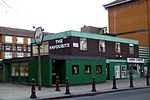Avondale Park
1892 establishments in EnglandLondon geography stubsParks and open spaces in the Royal Borough of Kensington and ChelseaProtected areas established in 1892

Avondale Park is a small park in the Royal Borough of Kensington and Chelsea, London, England, between Walmer and Sirdar Roads. It has a mix of formal gardens, sports facilities and lawns. Notably, it is home to what is believed to be Britain's first floral lawn.The park is named after the late Duke of Clarence and Avondale.
Excerpt from the Wikipedia article Avondale Park (License: CC BY-SA 3.0, Authors, Images).Avondale Park
Kenley Walk, London Notting Hill (Royal Borough of Kensington and Chelsea)
Geographical coordinates (GPS) Address Nearby Places Show on map
Geographical coordinates (GPS)
| Latitude | Longitude |
|---|---|
| N 51.5102 ° | E -0.2125 ° |
Address
Romilly House
Kenley Walk
W11 4AL London, Notting Hill (Royal Borough of Kensington and Chelsea, Wilsham Street Estate)
England, United Kingdom
Open on Google Maps









